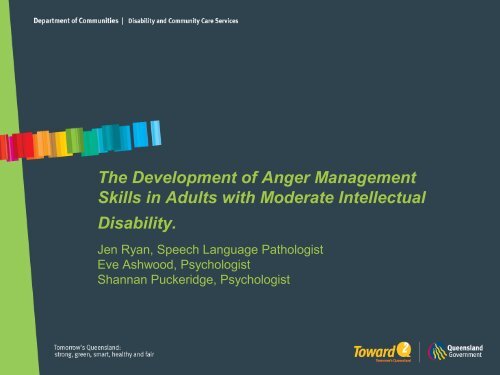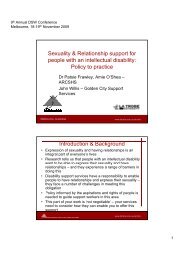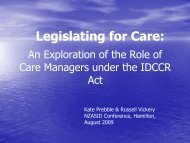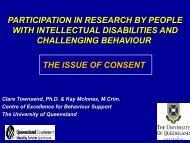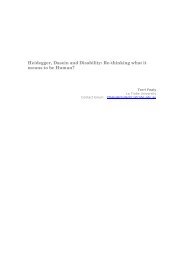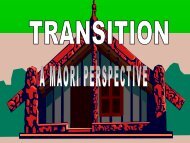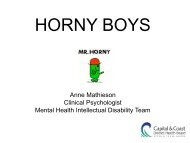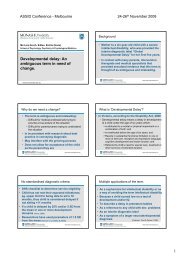The development of anger management skills in adults with ...
The development of anger management skills in adults with ...
The development of anger management skills in adults with ...
- No tags were found...
Create successful ePaper yourself
Turn your PDF publications into a flip-book with our unique Google optimized e-Paper software.
<strong>The</strong> Development <strong>of</strong> Anger ManagementSkills <strong>in</strong> Adults <strong>with</strong> Moderate IntellectualDisability.Jen Ryan, Speech Language PathologistEve Ashwood, PsychologistShannan Puckeridge, Psychologist
Overview• Background to Anger Management• <strong>The</strong> “How Anger Works and Keep<strong>in</strong>gCool” Programme• Results <strong>of</strong> three groups• Future directions
What is Anger?• Anger is an emotional state <strong>in</strong>fluenced by physiological andcognitive factors.• <strong>The</strong> emotion <strong>of</strong> <strong>anger</strong> is usually a response to a specific triggerwhich is mediated by the person’s beliefs and expectationsabout the situation.• Novaco (1975) views <strong>anger</strong> as an emotion <strong>with</strong> threecomponents; physiological, behavioural and cognitive.– <strong>The</strong>se are addressed <strong>in</strong> therapy by us<strong>in</strong>g relaxation, behaviouralcop<strong>in</strong>g <strong>skills</strong> and cognitive restructur<strong>in</strong>g.• Anger <strong>management</strong> programs <strong>in</strong> which participants are taughttechniques for cop<strong>in</strong>g <strong>with</strong> <strong>anger</strong>-provok<strong>in</strong>g situations areeffective and useful <strong>in</strong> decreas<strong>in</strong>g the expression <strong>of</strong> <strong>anger</strong> byclients <strong>with</strong> <strong>in</strong>tellectual disability.
Anger <strong>in</strong> Intellectual Disability• <strong>The</strong>re is prelim<strong>in</strong>ary evidence that people <strong>with</strong> disability present <strong>with</strong>higher rates <strong>of</strong> <strong>anger</strong> control problems compared to people <strong>with</strong>outdisabilities (Hagiliassis, et al., 2005; Rose & Gerson, 2009; Smith,Branford, Collacott, Cooper, & McGrother, 1996)• People <strong>with</strong> <strong>in</strong>tellectual disability <strong>of</strong>ten have unmet physical and<strong>in</strong>terpersonal needs. <strong>The</strong>se life experiences can lead to personaldistress, manifested as <strong>anger</strong>.• Anger expressed as aggression can result <strong>in</strong> obvious negativeoutcomes for the <strong>in</strong>dividual <strong>with</strong> a disability <strong>in</strong>clud<strong>in</strong>g;– Restricted opportunities– Limited access to the community– Limited accommodation placements– Lack <strong>of</strong> available carers– Impaired family and social relationships– Poor physical and emotional well-be<strong>in</strong>g
Target Group• Individuals <strong>with</strong>– Intellectual disability.– High Support Needs.– Aged 18-65 years <strong>of</strong> age• <strong>The</strong> person may also have challeng<strong>in</strong>g behaviour.
<strong>The</strong> “How Anger Works and Keep<strong>in</strong>gCool” Programme• 8 week programme• 2 hour sessions• Provided <strong>with</strong> handouts, worksheets, carer<strong>in</strong>formation sheets and homework tasks.• Pre-group and post-group <strong>in</strong>terviews andassessments.
Interviews & Assessments• Knowledge Questionnaire– Developed for the programme to ascerta<strong>in</strong> current understand<strong>in</strong>g <strong>of</strong>physiological, cognitive and behavioural components <strong>of</strong> <strong>anger</strong> foreach participant.– A similar questionnaire was adm<strong>in</strong>istered to the participant’s careror family.– Example Questions:• What do you do when you get angry?• If you had to rate your <strong>anger</strong> out <strong>of</strong> 5 (1 be<strong>in</strong>g that it is not bad at all and5 be<strong>in</strong>g that it is really bad) what would it be?• How much does the Anger worry you? (1 be<strong>in</strong>g that it is doesn’t worryyou at all and 5 be<strong>in</strong>g that it is really worries you) what would it be?• Draw (or write) on the body what happens to you when you get angry
Interviews & Assessments• <strong>The</strong> Aggression Questionnaire– Developed by Buss and Perry (1992)– 29 statements where people are asked to <strong>in</strong>dicate howuncharacteristic or characteristic each statement is, us<strong>in</strong>g afive-po<strong>in</strong>t scale.– Normative sample was 1,253 <strong>in</strong>dividuals <strong>with</strong>out <strong>in</strong>tellectualdisability.– Scale adapted for participants, enabl<strong>in</strong>g more concreterepresentation <strong>of</strong> the abstract concept.
Session One – Introduction to theProgramme• Understand<strong>in</strong>g the difference between <strong>anger</strong> andaggression (i.e., emotion <strong>of</strong> <strong>anger</strong> vs. physicality <strong>of</strong>aggression).• Beg<strong>in</strong> develop<strong>in</strong>g group trust and safety amongstmembers• Establish<strong>in</strong>g group rules, goals and commitment tochange
Session Two – How Anger Works• Recognis<strong>in</strong>g the physical and cognitive symptoms <strong>of</strong><strong>anger</strong> (generic body signals <strong>of</strong> <strong>anger</strong>)• Introduc<strong>in</strong>g the volcano model <strong>of</strong> <strong>anger</strong>• Ga<strong>in</strong><strong>in</strong>g awareness <strong>of</strong> the participant’s own physicalsigns <strong>of</strong> <strong>anger</strong>• Introduc<strong>in</strong>g self-monitor<strong>in</strong>g task – How do I feel book.
Session Three: Triggers and Keep<strong>in</strong>gCool• Recognis<strong>in</strong>g <strong>anger</strong> triggers (us<strong>in</strong>g How I feel bookand generic triggers to identify what makes theparticipant angry)• Identify<strong>in</strong>g and us<strong>in</strong>g was to reduce tension and keepcool (progressive muscle relaxation, deep breath<strong>in</strong>g)• Learn<strong>in</strong>g new ways to keep cool
Session Four: Identify<strong>in</strong>g Feel<strong>in</strong>gs andLook<strong>in</strong>g at Consequences• Identify<strong>in</strong>g and labell<strong>in</strong>g feel<strong>in</strong>gs other than <strong>anger</strong>• Dist<strong>in</strong>guish<strong>in</strong>g between different types <strong>of</strong> feel<strong>in</strong>gs(how it feels <strong>in</strong> the body, why we feel differentfeel<strong>in</strong>gs)• Recognis<strong>in</strong>g the costs <strong>of</strong> becom<strong>in</strong>g aggressive• Understand<strong>in</strong>g that we are <strong>in</strong> control <strong>of</strong> ourbehavioural choices
Session Five and Six: EffectiveCommunication• Introduc<strong>in</strong>g the concept <strong>of</strong> <strong>anger</strong> rights andresponsibilities (Bill <strong>of</strong> Rights)• Introduc<strong>in</strong>g the concept <strong>of</strong> ‘keep<strong>in</strong>g cool’ through theuse <strong>of</strong> assertiveness• Practis<strong>in</strong>g be<strong>in</strong>g assertive
Session Seven: Understand<strong>in</strong>g howTh<strong>in</strong>k<strong>in</strong>g Affects Feel<strong>in</strong>g• Identify<strong>in</strong>g self-talk• Creat<strong>in</strong>g a personalised emotional toolbox• Relat<strong>in</strong>g the tools to the volcano model• Prepar<strong>in</strong>g group for f<strong>in</strong>al session.
Session Eight: Putt<strong>in</strong>g it all together• Review<strong>in</strong>g content covered• Discuss<strong>in</strong>g what each participant found helpful andunhelpful (us<strong>in</strong>g feedback form)• Discuss<strong>in</strong>g each participant’s favourite tool to usewhen they feel angry• Prepar<strong>in</strong>g for possible relapse (mak<strong>in</strong>g a symbol tohelp them remember the group)• Group closure (award<strong>in</strong>g certificates)
ParticipantsSex Age Disability Liv<strong>in</strong>gArrangementReported AggressionM 30 Moderate ID Independently Physical altercations, self-<strong>in</strong>juriousand use <strong>of</strong> weaponsF 25 Moderate ID Supported Yell, scream, slam doorsM 34 Moderate ID, DownSyndromeSupported by familyYell, scream, slam doors, self<strong>in</strong>jurious,kick and push objectsM 55 Fragile X, Epilepsy Independently <strong>with</strong> m<strong>in</strong>imal Verbal aggression and threaten<strong>in</strong>gsupervisionbehaviourF 30 Moderate ID Supported by family Yell, scream, slam doors, physicalaggression towards motherM 28 ID Independently Yell, property destruction andthreaten<strong>in</strong>g behaviourF 22 ID Supported by family Yell, throw objects
Sex Age Disability Liv<strong>in</strong>gArrangementReported AggressionM 19 Moderate ID andSchizophreniaSupportedYell, Slam doors, throw objects,threaten<strong>in</strong>g behaviour, abscond<strong>in</strong>gF 25 Moderate ID,Cerebral Palsy,DeafSupported by familyYell, slam doors, physicallyaggressiveF 22 ID Supported by family Yell, throw objects
Sex Age Disability Liv<strong>in</strong>g Arrangement Reported AggressionF 41 Moderate ID Supported Yell, ignores, refuse to participate,smear<strong>in</strong>g behavioursF 25 Moderate ID, CerebralPalsy, DeafSupported by familyPhysical aggression, yell, cryM 29 Moderate ID Supported Bite, hit, swearF 21 Moderate ID Supported by family Yell, cry, <strong>in</strong>ternalises <strong>anger</strong>F 25 Moderate ID,Down SyndromeM 23 Moderate ID,Down SyndromeF 30 Moderate ID,Mental illnessSupported by familySupported by familySupported by familyYell, doesn’t listen, refuse to participateYell, swear, throws objects, pushes anduses <strong>in</strong>timidat<strong>in</strong>g behaviourYell, scream, swear, antisocialM 31 Mild ID Supported by family Internalises emotions, refuses toparticipateM 28 Moderate ID Supported by family Cry, <strong>with</strong>draw, antagonis<strong>in</strong>g behaviourM 20 Moderate ID,Mental IllnessSupportedYell, scream, swear, threaten<strong>in</strong>gbehaviour, slam doors
Results• Knowledge about <strong>anger</strong>:– Body Signals <strong>of</strong> Anger6543Pre-GroupPost-Group210Group One Group Two Group Three
Results• Knowledge about <strong>anger</strong>:– Triggers <strong>of</strong> <strong>in</strong>dividual participant <strong>anger</strong>3.532.521.5Pre-GroupPost-Group10.50Group One Group Two Group Three
Results• Knowledge about <strong>anger</strong>:– Strategies that can help keep cool43.532.52Pre-GroupPost-Group1.510.50Group One Group Two Group Three
Results• How the participants rated their <strong>anger</strong>54.543.532.52Pre-GroupPost-Group1.510.50Group One Group Two Group Three
Results• <strong>The</strong> participants worry about their <strong>anger</strong>54.543.532.52Pre-GroupPost-Group1.510.50Group One Group Two Group Three
Results• <strong>The</strong> carers worry about the participants <strong>anger</strong>54.543.532.52Pre-GroupPost-Group1.510.50Group One Group Two Group Three
Results• <strong>The</strong> carers rat<strong>in</strong>g <strong>of</strong> the severity <strong>of</strong> the participants <strong>anger</strong>4.543.532.52Pre-GroupPost-Group1.510.50Group One Group Two Group Three
Results• Aggression Questionnaire1201008060Pre-GroupPost-Group40200Group One Group Two Group Three
Results• Aggression Questionnaire – Physical aggression3530252015Pre-GroupPost-Group1050Group One Group Two Group Three
Results• Aggression Questionnaire – Verbal Aggression2018161412108Pre-GroupPost-Group6420Group One Group Two Group Three
Results• Aggression Questionnaire - Hostility30252015Pre-GroupPost-Group1050Group One Group Two Group Three
Results• Aggression Questionnaire - Anger30252015Pre-GroupPost-Group1050Group One Group Two Group Three
Results• Carer Reports– “he hasn’t been violent for weeks”– “she has been us<strong>in</strong>g deep breaths and squeez<strong>in</strong>g lemonswhen she is gett<strong>in</strong>g angry at the shops”– “his family have told us (day program) that he has been lessangry these last few weeks”– “the hassle log is really help<strong>in</strong>g her. Can we have morepages so she can keep do<strong>in</strong>g it once the group stops?”– “this has been really helpful for him. Can some <strong>of</strong> our otherclients come to your next group?”
Future Directions• Encourag<strong>in</strong>g other agencies to implement supportive strategiesto enable the participants to cont<strong>in</strong>ue to manage their <strong>anger</strong>effectively.• Negotiation to be added as a component <strong>of</strong> the effectivecommunication sessions• More objective behavioural data to be collected throughout theduration <strong>of</strong> the program• Carer workshops at important po<strong>in</strong>ts <strong>in</strong> the program –particularly after the body signals <strong>of</strong> <strong>anger</strong>, and effectivecommunication sessions.• Increased 1:1 support <strong>with</strong> each group member to allow them todiscuss more sensitive issues, and consolidate group content.
From a participant:“Com<strong>in</strong>g to your group kicked butt!”


